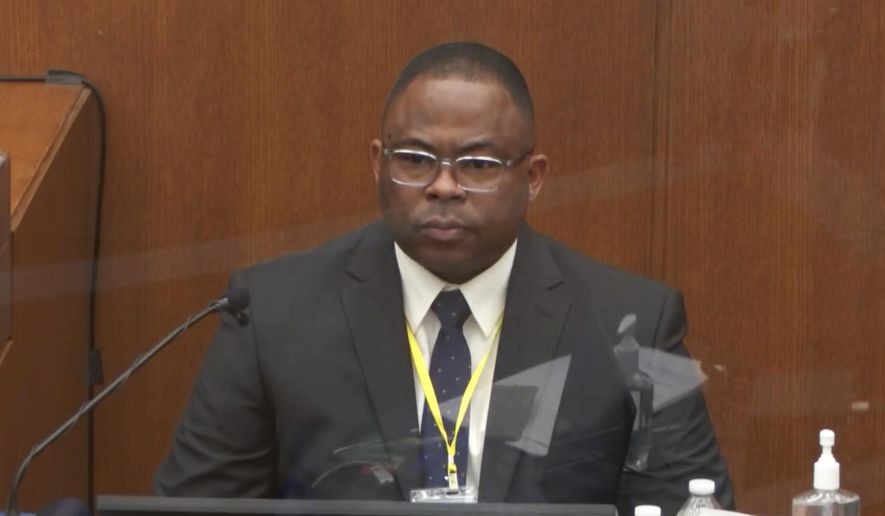MINNEAPOLIS (AP) — Officer Derek Chauvin had his knee on George Floyd’s neck — and was bearing down with most of his weight — the entire 9½ minutes the Black man lay facedown with his hands cuffed behind his back, a use-of-force expert testified Wednesday at Chauvin’s murder trial.
Jody Stiger, a Los Angeles Police Department sergeant serving as a prosecution witness, said that based on his review of video evidence, Chauvin knelt on Floyd’s neck or neck area from the time officers put Floyd on the ground until paramedics arrived.
“That particular force did not change during the entire restraint period?” prosecutor Steve Schleicher asked as he showed the jury a composite image of five photos taken from the various videos of the arrest.
“Correct,” Stiger replied.
As he did on Tuesday, Chauvin attorney Eric Nelson sought to point out moments in the video footage when, he said, Chauvin’s knee did not appear to be on Floyd’s neck but on his shoulder blade area or the base of his neck. Stiger did not give much ground, saying the officer’s knee in some of the contested photos still seemed to be near Floyd’s neck.
The defense attorney also asked Stiger whether video showed Floyd picked up his head and moved it at times.
“Slightly, yes. He attempted to,” Stiger replied.
Chauvin, 45, is charged with murder and manslaughter in Floyd’s death May 25. Floyd, 46, was arrested outside a neighborhood market after being accused of trying to pass a counterfeit $20 bill. A panicky-sounding Floyd struggled and claimed to be claustrophobic as police tried to put him in a squad car, and they pinned him down on the pavement.
Bystander video of Floyd crying that he couldn’t breathe as onlookers yelled at Chauvin to get off him sparked protests and scattered violence around the U.S. and triggered a reckoning over racism and police brutality.
Nelson has argued that the now-fired white officer “did exactly what he had been trained to do over his 19-year career,” and he has suggested that the illegal drugs in Floyd’s system and his underlying health conditions are what killed him, not Chauvin’s knee.
Nelson seized on the drug angle in cross-examining Stiger, playing a snippet of then-Officer J. Kueng’s body-camera video and asking whether Stiger could hear Floyd say, “I ate too many drugs.”
Stiger replied that he could not make out those words in the footage. Prosecutors did not bring up the issue when they questioned Stiger again.
Nelson has also contended that the officers on the scene perceived the onlookers as an increasingly hostile crowd and were distracted by them. On Tuesday, the defense attorney got some police witnesses to acknowledge that jeering bystanders can make it more difficult for officers to do their duty.
On Wednesday, Stiger told the jury, “I did not perceive them as being a threat,” even though some onlookers were name-calling and using foul language. He added that most of the yelling was due to “their concern for Mr. Floyd.”
Nelson’s voice rose as he asked Stiger how a reasonable officer would be trained to view a crowd while dealing with a suspect, “and somebody else is now pacing around and watching you and watching you and calling you names and saying (expletives).” Nelson said “this could be viewed by a reasonable officer as a threat.”
“As a potential threat, correct,” Stiger said.
Chauvin’s lawyer also noted that dispatchers had described Floyd as between 6 feet and 6-foot-6 and possibly under the influence. Stiger agreed it was reasonable for Chauvin to come to the scene with a heightened sense of awareness.
Stiger further agreed with Nelson that an officer’s actions must be viewed from the point of view of a reasonable officer on the scene, not in hindsight.
The defense attorney suggested that when Chauvin told Floyd to “relax,” he was trying to calm him down and reassure him. And Nelson said that given typical EMS response times, it was reasonable for Chauvin to believe that paramedics would be there soon.
Stiger also testified that Chauvin squeezed Floyd’s fingers and pulled one of his wrists toward his handcuffs, a technique that uses pain to get someone to comply, but he did not appear to let up while Floyd was restrained.
“Then at that point it’s just pain,” Stiger said.
Asked by prosecutors whether Chauvin had an obligation to take Floyd’s distress into account as he was considering how much force to use, Stiger replied: “Absolutely. As as the time went on, clearly in the video, you could see that Mr. Floyd’s … health was deteriorating. His breath was getting lower. His tone of voice was getting lower. His movements were starting to cease.”
“So at that point, as a officer on scene, you have a responsibility to realize that, ‘OK, something is not right,’” Stiger continued. “’Something has changed drastically from what was occurring earlier.’ So therefore you have a responsibility to take some type of action.”
It was Stiger’s second day on the stand. On Tuesday, he testified that the force used against Floyd was excessive. He said police were justified in using force while Floyd was resisting their efforts to put him in the squad car. But once Floyd was on the ground and stopped resisting, officers “should have slowed down or stopped their force as well.”
Instead of closing ranks to protect a fellow officer behind what has been dubbed the “blue wall of silence,” some of the most experienced members of the Minneapolis force, including the police chief, have taken the stand to openly condemn Chauvin’s actions as excessive and contrary to his training and departmental policy.
According to testimony and records submitted in court, Chauvin underwent training in 2016 and 2018 in de-escalation techniques to calm down people in crisis and instruction in how officers must use the least amount of force required to get a suspect to comply.
___
Webber reported from Fenton, Michigan.




Please read our comment policy before commenting.